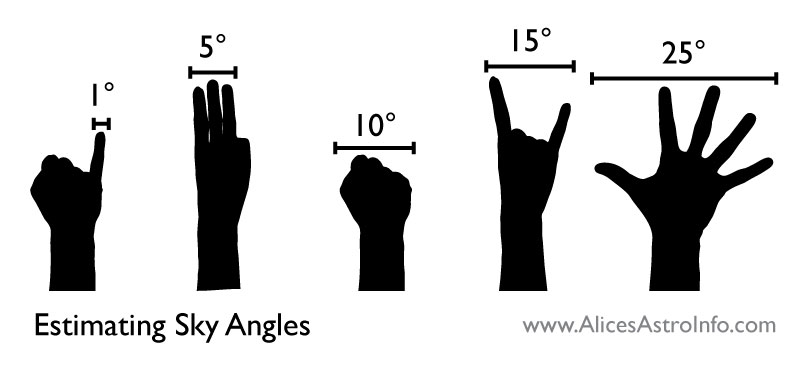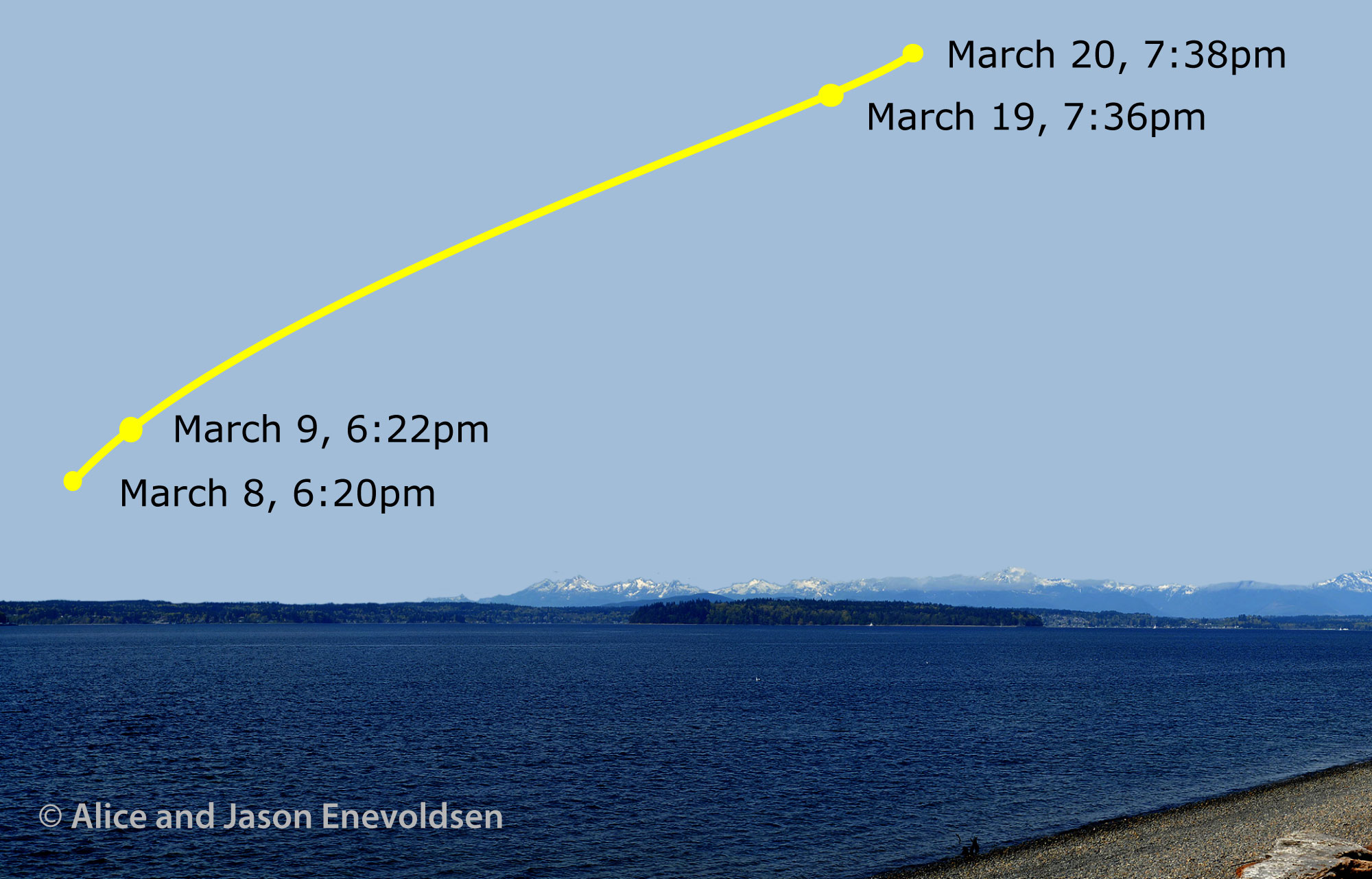**This is an old post I thought you’d like.**
Okay. So. You’re trying to find the comet. This is a basic primer on how to estimate where things are in the sky without stars to help you.
Estimating Degrees on the Sky
Use Your Hands
 [1]
[1]Hold your hand at arms’ length. This works for any size hands assuming you are close to average human proportions, but only if you completely extend your arm.
Actually, this graphic pretty much says it all.
Your fist at arms’ length is about ten degrees wide. Your pinkie finger is one or one and a half.
Know Where You Are and What You Can See
The rest of this article is specific to finding the comet from near Seattle. If you’d like to find it in another location, you’ll need to know exactly where due West is, and the altitude (height) and aziumuth (direction, 270 degrees is due West, and north of West is larger numbers) of the comet for the specific day and time of observation. Try Sky & Telescope [2] for observing data.
Believe it or not, we’ve had good luck seeing this cute little comet from Seattle, between the clouds. You’ll need binoculars.
From the point of Lincoln Park you can easily see Blake Island. It’s the dark one north of Vashon. The South end of Blake Island is at 269°–almost due West (270°). The North end of Blake Island is 15° (the distance of your pointer to your pinkie) towards North, at 284°.
From Alki Point (the one with the lighthouse, not the one with the Statue of Liberty) due West (again, 270°) is the South end of Bainbridge Island.
From the far south side of West Seattle: Arbor Heights, 270° is the North end of Vashon Island.
You can figure this out for yourself pretty quick with a Puget Sound map of your choice [3]. Pinpoint your viewing location and what visible marker on a nearby island or the peninsula is exactly West from you?
Height
To determine how many degrees up into the sky something is, you’re measuring from the perfectly flat horizon. Using the far edge of the water of Puget Sound is a great estimate for this.
Finding the Comet (from Seattle)
Comet becomes visible in binoculars about half an hour after sunset. Forty-five minutes after sunset you might see it with just your eyes.
Monday, March 18, 2013 — Sunset: 7:20pm
- 7:50pm at 280° (one fist North of due West)
13° up (A little less than your pinkie-to-index finger distance).
- 8:25pm at 286° (your pinkie-to-index finger distance North of due West)
7.5° up (between the height of your fist and the height of three fingers)
- 9:00pm at 292° (not quite your full-spread hand North of due West)
2° up (a bit more than your pinkie-width)
Tuesday, March 19, 2013 — Sunset: 7:22pm
- 7:52pm at 282° (between a fist and your pinkie-to-index finger distance North of due West)
13.5° up (A little less than your pinkie-to-index finger distance).
- 8:29pm at 288° (your pinkie-to-index finger distance North of due West)
7.5° up (between the height of your fist and the height of three fingers)
- 9:06pm at 295° (Your full-spread hand North of due West)
2° up (a bit more than your pinkie-width)
Wednesday, March 20, 2013 — Sunset: 7:23pm (Come to the Sunset Watch! [5])
- 7:53pm at 284.5° (between a fist and your pinkie-to-index finger distance North of due West)
14° up (A little less than your pinkie-to-index finger distance).
- 8:32pm at 291° (Almost your full-spread hand North of due West)
8° up (between the height of your fist and the height of three fingers)
- 9:11pm at 298° (Your full-spread hand plus three fingers North of due West)
2° up (a bit more than your pinkie-width)
Thursday, March 21, 2013 — Sunset: 7:25pm
- 7:55pm at 286.5° (Your pinkie-to-index finger distance North of due West)
14.5° up (Your pinkie-to-index finger distance).
- 8:36pm at 294° (Your full-spread hand North of due West)
8° up (between the height of your fist and the height of three fingers)
- 9:17pm at 301° (Your full-spread hand plus three fingers North of due West)
2° up (a bit more than your pinkie-width)
Friday, March 22, 2013 — Sunset: 7:26pm
- 7:56pm at 289° (Between your pinkie-to-index finger and your full-spread hand distance North of due West)
15° up (Your pinkie-to-index finger distance).
- 8:39pm at 296° (Your full-spread hand North of due West)
8° up (between the height of your fist and the height of three fingers)
- 9:22pm at 304° (Your full-spread hand plus your fist North of due West)
2° up (a bit more than your pinkie-width)
Saturday, March 23, 2013 — Sunset: 7:28pm
- 7:58pm at 291° (Between your pinkie-to-index finger and your full-spread hand distance North of due West)
15° up (Your pinkie-to-index finger distance).
- 8:43pm at 299° (Your full-spread hand plus your fist North of due West)
8° up (between the height of your fist and the height of three fingers)
- 9:27pm at 306.5° (Your full-spread hand plus your pinkie-to-index finger distance North of due West)
2° up (a bit more than your pinkie-width)
Sunday, March 24, 2013 — Sunset: 7:29pm
- 7:59pm at 293° (Your full-spread hand distance North of due West)
15.5° up (Your pinkie-to-index finger distance).
- 8:46pm at 301° (Your full-spread hand plus your fist North of due West)
8.5° up (between the height of your fist and the height of three fingers)
- 9:33pm at 309.5° (Your full-spread hand plus your pinkie-to-index finger distance North of due West)
2° up (a bit more than your pinkie-width)
Basics
I made this graphic for West Seattle Blog [3]. It’ll help you in a general sense, but not on a daily basis.
Want More?
One Minute Astronomer [7] also has a good general write-up about estimating the sky. It is more detailed than mine, more general than mine, and outlines the basics that most amateur astronomers use every night.
I also want to give credit where credit is due. I used hand images, with permission, from all-silhouettes.com. I modified them significantly to suit my purpose. Stanislav makes cool images, but the website is full of links to spam and malware.
![]()
~ A l i c e !

